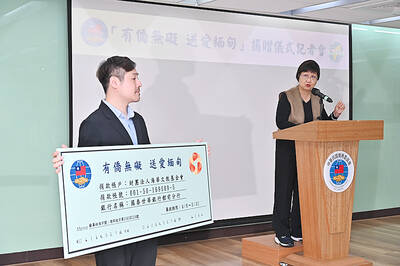After being kept in a warehouse since 2003, the reactor pressure vessel for Unit One of the Fourth Nuclear Power Plant was yesterday finally moved out of storage to be installed on its pedestal.
However, environmentalists expressed concern about the safety of the reactor component. They said that, during a visit last month with Japanese anti-nuclear activists to the plant in Gongliao Township, Taipei County, they noticed that the pressure vessel had started showing signs of rust, which they blamed on lax management.
Meanwhile, the Taiwan Power Company (Taipower) said yesterday that plans for the reactor to go into commercial operation by July next year would be indefinitely delayed.
The 1,007-tonne reactor pressure vessel was completed in 2001 by Babcock-Hitachi, a subcontractor of General Electric. It had been in the warehouse since June, 2003, after it was shipped from Japan. According to Taipower's original plans, construction of the reactor should have been completed by the end of last year.
Lin Yuan-te (林源得), deputy manager for Taipower's Lungmen Construction Office in Gongliao, confirmed yesterday that the vessel was brought to the construction site yesterday.
He said that the pressure vessel would be loaded onto its pedestal on Friday.
Another reactor will be installed in a few years at the power plant, which has a projected total capacity of 2,700MW.
Lin said that as of the end of last month, the plant was about 58 percent complete.
"Progress remains behind the original schedule. The original start-up date for the plant's first reactor, July 2006, will definitely be postponed," he said.
Lin said that the Executive Yuan is still reviewing Taipower's evaluation report on the delay, and that it remains uncertain how long the delay will be.
Meanwhile, anti-nuclear activists were skeptical about the safety of the first reactor owing to the rust that had accumulated on the pressure vessel.
"Before installation, Taipower should explain the massive rust build-up to both residents [of Gongliao Township] and the general public. We'd like to know if it would cause any problem," Lai Wei-chieh (賴偉傑), executive-general of the Green Citizens' Action Alliance, said yesterday.
Lai said that the presence of rust was just one of the examples showing Taipower's lax management with its sub-constructors. In June 2002, it was found that questionable materials were used in the construction of a reactor pedestal for the plant.
Lai said that the designs for the construction, which date to January 1998, should be reviewed and updated.
Lai said that the same type of reactor, an advanced boiling-water reactor (ABWR), was used in a nuclear power plant in Kashiwazaki, Japan, where several nuclear accidents have occurred. Due to persistent campaigning by the anti-nuclear movement, the latest ABWR reactor in Japan had been built under stricter criteria, such as incorporating a design more resistant to earthquakes.
Lin said yesterday that Taipower has been in close communication with people concerned about nuclear power for years and that all problems raised by the public have been fixed.

DEFENSE: The National Security Bureau promised to expand communication and intelligence cooperation with global partners and enhance its strategic analytical skills China has not only increased military exercises and “gray zone” tactics against Taiwan this year, but also continues to recruit military personnel for espionage, the National Security Bureau (NSB) said yesterday in a report to the Legislative Yuan. The bureau submitted the report ahead of NSB Director-General Tsai Ming-yen’s (蔡明彥) appearance before the Foreign and National Defense Committee today. Last year, the Chinese People’s Liberation Army (PLA) conducted “Joint Sword-2024A and B” military exercises targeting Taiwan and carried out 40 combat readiness patrols, the bureau said. In addition, Chinese military aircraft entered Taiwan’s airspace 3,070 times last year, up about

Taiwan is stepping up plans to create self-sufficient supply chains for combat drones and increase foreign orders from the US to counter China’s numerical superiority, a defense official said on Saturday. Commenting on condition of anonymity, the official said the nation’s armed forces are in agreement with US Admiral Samuel Paparo’s assessment that Taiwan’s military must be prepared to turn the nation’s waters into a “hellscape” for the Chinese People’s Liberation Army (PLA). Paparo, the commander of the US Indo-Pacific Command, reiterated the concept during a Congressional hearing in Washington on Wednesday. He first coined the term in a security conference last

A magnitude 4.3 earthquake struck eastern Taiwan's Hualien County at 8:31am today, according to the Central Weather Administration (CWA). The epicenter of the temblor was located in Hualien County, about 70.3 kilometers south southwest of Hualien County Hall, at a depth of 23.2km, according to the administration. There were no immediate reports of damage resulting from the quake. The earthquake's intensity, which gauges the actual effect of a temblor, was highest in Taitung County, where it measured 3 on Taiwan's 7-tier intensity scale. The quake also measured an intensity of 2 in Hualien and Nantou counties, the CWA said.

The Overseas Community Affairs Council (OCAC) yesterday announced a fundraising campaign to support survivors of the magnitude 7.7 earthquake that struck Myanmar on March 28, with two prayer events scheduled in Taipei and Taichung later this week. “While initial rescue operations have concluded [in Myanmar], many survivors are now facing increasingly difficult living conditions,” OCAC Minister Hsu Chia-ching (徐佳青) told a news conference in Taipei. The fundraising campaign, which runs through May 31, is focused on supporting the reconstruction of damaged overseas compatriot schools, assisting students from Myanmar in Taiwan, and providing essential items, such as drinking water, food and medical supplies,